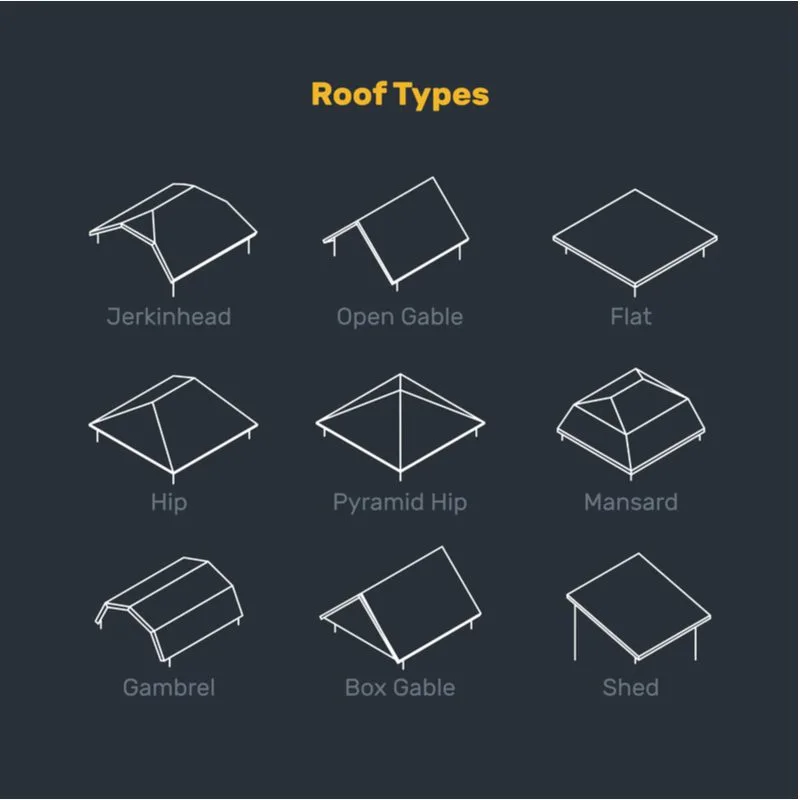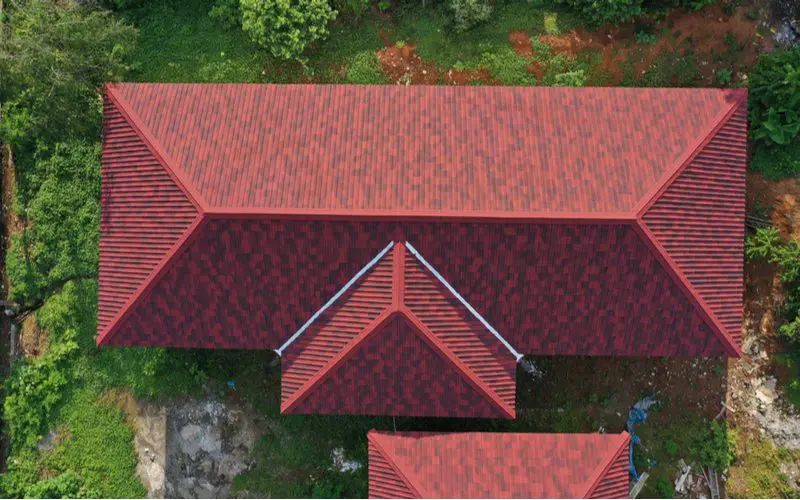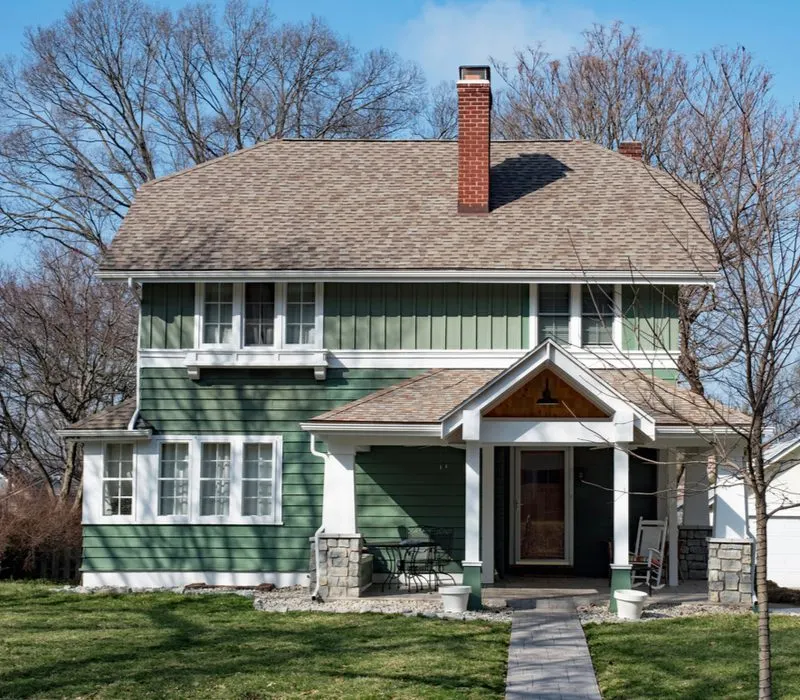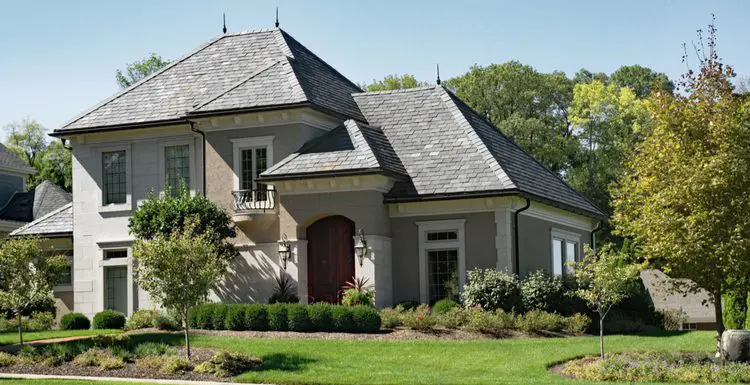Roofs vary greatly depending on factors like house style, region, weather, and budget.
To learn everything you could ever want to know about hip roof design, follow along with this ridiculously detailed guide.
What is a Hip Roof?
In short, a hip roof is a particular style of roof that has a sloped angle on each side meeting in a hip on top.
While it sounds simple, it’s not. There are actually 5 types of hip roofs and a few features that make them the “hippest” of all roofs.
Structure

Inna Harlamoff/Shutterstock
Let’s start with the basics. You want to know what a hip roof is, so let’s take a look at the structure and what parts of it are unique to other roof types.
If you were to drive around your neighborhood, chances are the majority of rooflines you’d see would be hip roofs.
But what exactly makes it a hip roof? The answer is simple. The underlying structure of a hip roof is similar to that of a gable.
- In a gable roof, two sloped sides meet on top. The ridge beam is what connects them.
- In a hip roof, there is the addition of what is referred to as the hip ends—the sloping ends where the flat face of a gable would be.
The hip itself is the spot where the regular sides meet the hip ends. The hip rafters are supporting these angled corners.
In summary, the ridge beam is the top angle where all sides connect, and the hips are the angled corners where the sides adjoin the hip ends.
The interior structure of the roof is similar to that of a gable, but the hip end rafters are called jack rafters, and there is the addition of the hip rafters.
There are five common styles of hip roofs:
- Regular
- Pyramid hip
- Half-hip
- Cross-hip
- Hip and valley
The regular hip is the one described above. The pyramid hip is the same, but instead of a ridge at the top, the roof sides meet at a single point.
Both having all of the roof’s sides the same length and deepening the hip ends’ angle to lengthen them can produce this effect.
The cross-hip, hip, and valley are very similar to each other. Making an L-shaped roofline results in the cross-hip.
Imagine two hip roofs intersecting at a perpendicular angle to meet at the corner. This forms a roof with six angled sides and still only two hip ends.
The hip and valley design also features intersecting rooflines, but they do not meet at the corner. This type of roof occurs when two hip roofs meet at a perpendicular angle, but only one roof is intersecting the other.
This forms a roof with seven sides. There are also three hip ends still visible, as one roof is a complete hip roof, and the intersecting one is only cut off on one side.
The final variation on hip roofs is the half-hip. The half-hip is odd by most roofing standards. It is a mash-up of the hip roof and the gable roof. It looks like a gable roof.
But the two longer sides (the sides that a gable roof would have) extend down beyond the hip ends. This forms more overhang on the side of the roof without giving it a flat face like a gable.
Cost
There are a lot of aspects to consider when trying to price a roof. The overall size, complexity, slope, materials, and more can be decisive factors in changing the cost of a roof cost.
That said, you can expect to pay around $20,000–$50,000 for gable roofing on an average home.
The cost typically works out to $8–$12 per square foot. Gable roofs are usually cheaper—about $6–$9 per square foot—while other roofs like the mansard roof tend to cost more—around $10–$14 per square foot.
Location
Hip roofs have been around for centuries. They came to the U.S. in the 18th century but were commonplace in Italy and southern Europe long before that.
Hip roofs can be found all over the world now, though they are more prevalent in Europe and North America.
Weather
Part of the reason for the hip roof’s popularity is due to its proven durability against all sorts of weather. The extreme slope of hip roofs is ideal for preventing snow buildup in northern climates.
The triangular structure also provides enough support so that if snow does build up, the roof won’t collapse. Hip roofs are also resistant to high winds and rain. They are strong against torque from any angle because all sides are slanted.
The high slope of hip roofs helps negate the effects of forceful winds. By creating an angle away from the house, the wind can blow over, spiral around, and encircle the house without pushing too much on one side.
If the roof were flatter, it would simply act as another surface for the wind to butt against. A sloped roof creates a rounder shape for the house, making it easy for the wind to follow. This is vital when strong winds blow.
If the roof is too flat, the wind that comes up the sides of the house will rush down against the roof, creating a vacuum rather than slipping over it.
Overall, hip roofs have better load-bearing support and strength against extreme weather. They are the safest option for hurricane-, tornado-, or blizzard-prone areas.
Hip Roof Pros and Cons

Kokean Mabur/Shutterstock
While hip roofs are some of the best designs for several reasons, they also have their downsides. Let’s take a look at all the pros and cons of hip roofs, so you can get a better sense of how they compare to other styles.
Pros
- Hip roofs are extremely structurally sound. They are one of the most robust roof shapes and are very durable.
- They protect against harsh weather like high winds, snow, and rain.
- Hip roofs look good and go with any house style or shape.
- They provide more effective drainage and runoff control.
- There’s plenty of extra attic room or living space.
- Hip roofs can accommodate all roofing types, from metal paneling to shingles and more.
- Hip roofs are affordable and cheaper than fancier roof styles.
Cons
- Hip roofs have an increased risk of leaks. When you add more roof seams, your chances of springing a leak always go up. Any roof with extras, like dormers, also faces an increased risk of leaks.
- Hip roofs are more expensive than gable roofs because they require more materials and planning to build. The extra jack rafters also increase the overall weight of the roof, meaning that if the house is not strong enough, you cannot install a hip roof.
- Hip roofs are harder to ventilate, and adding vents increases the risk of leaks.
Other Details

99art/Shutterstock
Just when you thought you’d run out of things to learn about hip roofs, there’s a bonus section. This is the guide that keeps on giving!
You already know that hip roofs are great for weather, are strong, and look cool, but did you know they can also have insurance benefits?
That’s right; if you live in a hurricane-prone area, your insurance company may give you a discount for owning a home with a hip roof.
Whether you are building a home, buying, or planning to change the roof, you may be eligible for up to a 32% discount on insurance.
You can have a wind mitigation report performed to gauge if you’re eligible for a discount if you already live in a home with a hip roof.
Some insurance companies provide this discount because hip roofs make so much difference against hurricanes that it’s worth it. Another fact you may not yet know about hip roofs is that they are easy to build.
Unlike gable roofs that require extra bracing or more complex roofs that can span several floors and styles of room, hip roofs are relatively simple to make.
They are four-sided, relatively symmetrical structures with a flat base. Each side is built in the same manner and can be finished the same way. They cost more to make, thanks to the need for more materials.
Finally, because of the open attic space and four sloped sides, hip roofs are some of the most energy-efficient roofs.
They deflect sun, wind, and snow, keeping the outside of the house protected. The inside space helps regulate temperature as well by giving hot air a place to vent in the summer and insulating with a pocket of warm air in the winter.
Things to Consider

Susan Law cain/Shutterstock
Whether you are looking to buy, build, or modify a home, there are several things to consider about hip roofs before investing.
- What is the climate and weather in your area? If you have a lot of precipitation and high wind or live in a hurricane-prone area, then a hip roof is a good idea.
- Can you afford it? While hip roofs are more expensive than gable designs, they also last longer and cost less than other roof types.
- Do you like how they look?
- What type of roofing do you want to use on it?
- How complex is your roofline?
- Does your insurance company provide a discount for owning a home with a hip roof?
- Have you had issues with drainage or leakage in the past?
- Do you plan to use the attic space or add dormers?
Frequently Asked Questions
Does a hip roof need ceiling joists?
Most hip roof designs require ceiling joists, but some like square or pyramid hip roofs don’t always need them. The inner structure of the roof is self-supporting.
Which is better: gable or hip roof?
While gable roofs are cheaper, hip roofs are better overall. They provide more resilience against harsh weather, are stronger, and are easier to build. They can have issues with ventilation and leaking, but in every other aspect, they are superior.
What is a hip on the roof?
The hip is the point at the roof where the sides meet; the angled corners where each sloped side touches. The shorter sloped sides are called the hip ends, and the peak is the ridge.
Is a hip roof strong?
Hip roofs are the strongest roofs aside from domes. They implement triangles in every aspect of their structure, providing a very stable base. The angle of the slope also dictates the level of strength, but they are more durable against the wind than any other residential roof.
Is hip roof cheaper than gable?
Hip roofs, generally speaking, are not cheaper than gable roofs. The price difference is minimal, but a hip roof usually costs $8-$12 per square foot, while gable roofs cost $6-$9 per square foot.
The Hippest Roof
And with this, you’ve reached the end of this insanely detailed guide to hip roofs. You know everything there is to know.
Hip roofs are a great option if you are looking for strength, resilience, weatherproofing, and style all at an affordable price.

